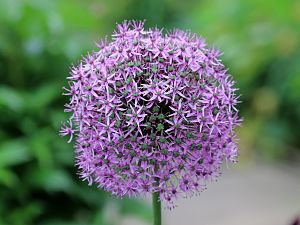Giant leek
| Giant leek | ||||||||||||
|---|---|---|---|---|---|---|---|---|---|---|---|---|

Giant Leek ( Allium giganteum ) |
||||||||||||
| Systematics | ||||||||||||
|
||||||||||||
| Scientific name | ||||||||||||
| Allium giganteum | ||||||||||||
| rule |
The Allium giganteum ( Allium giganteum ) is a leek-type ( Allium ) and belongs to the subfamily of Garlic Family (Allioideae) within the family of the Amaryllis (Amaryllidaceae). It originates from the Middle East and Central Asia : northern and western Afghanistan , northeastern Iran , southern Tajikistan , Turkmenistan and Uzbekistan . It is used as an ornamental plant in parks and gardens and as a cut flower.
description
The giant leek is a perennial herbaceous plant with a stature height of 80 to 150 cm. The parts of the plant give off a slight smell of onions. This geophyte forms an onion as a persistence organ, which has a diameter of 4 to 6 cm and a circumference of about 17 cm or more. The six to eight basal, upright, grayish-green, smooth leaves are linear or belt-shaped with a length of up to 50 cm and a width of up to 5 to 10 cm. The leaves begin to die off and dry up at the beginning of the anthesis .
The flowering time falls in summer. On a relatively thick, with a diameter of about 1 cm, round and hollow in cross-section, leafless inflorescence stem stands the dold-like inflorescence , which is spherical with a diameter of 10 to 14 cm. The hermaphrodite flowers are radial symmetry and threefold. The six equal-faceted bloom have different shades of violet and are a star shape. There are six stamens .
The number of chromosomes is 2n = 16.
Systematics
The first description of Allium giganteum was made by Eduard August von Regel in garden flora , Volume 32, 1883, p 97, 1113. Table A synonym for Allium giganteum rule is Allium procerum Trautv. ex rule .
Allium giganteum belongs to the section Compactoprason from the subgenus Melanocrommyum in the genus Allium .
use
The giant leek is mainly used as an ornamental plant in parks and gardens and sometimes as a cut flower .
The relatively large onions can be eaten raw or cooked; they are non-toxic and have a good mild taste. The leaves are eaten raw or cooked. The flowers are eaten raw and make a nice decoration on salads.
The sap is used as a repellent against moths. Allegedly all parts of the plant drive away insects and moles.
cultivation
The giant leek needs nutritious, but water-permeable, well-drained soil . It prefers a sunny, dry to slightly moist location, but does not tolerate waterlogging well. The bulbs are planted relatively deep. In Central Europe, the giant leek is hardy. Propagation takes place by onion division or by seeds.
Web links
- Thomas Meyer: Data sheet with identification key and photos at Flora-de: Flora von Deutschland (old name of the website: Flowers in Swabia )
- Allium giganteum - Common Name: Ornamental Onion - Erv Evan - North Carolina State University College of Agriculture and Life Sciences.
Individual evidence
- ↑ a b c d e f entry Allium giganteum at Ornamental Plants From Russia And Adjacent States Of The Former Soviet Union .
- ↑ a b c d Entry Allium giganteum at GRIN.
- ↑ a b c d e f g h Missouri Botanical Garden : Data sheet Allium giganteum .
- ↑ a b c d Allium giganteum entry in Plants For A Future .
- ^ Tropicos. [1]
- ↑ Entry in Tropicos .
- ↑ Entry in Kew World Checklist .
